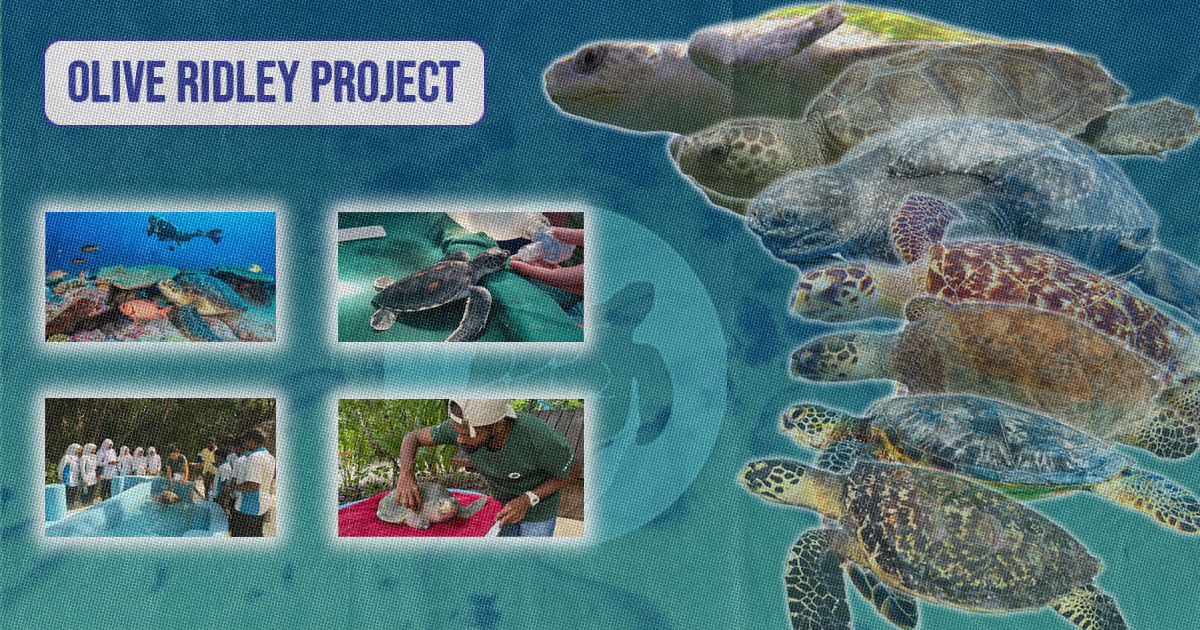Shell-ebrating sea turtles: a World Turtle Day guide to the Maldives' ocean ambassadors
Discover five remarkable species thriving in Maldivian waters and culture.

Artwork: Dosain
Sea Turtle Biology
Scaly skin: this helps reptiles conserve moisture as most of them live in dry, sunny and/or salty environments
Poikilothermic: their body temperature varies and depends largely on the temperature of their surroundings
Air breathers: all reptiles are born with lungs and use them to exchange gas from the atmosphere
Oviparous: they lay eggs (although some snakes, chameleons and lizards also give birth to live young)
Sea Turtle Populations in Maldives
Green turtles: Green turtles (Chelonia mydas) are the largest of all the hard-shelled sea turtles. They have a smooth, sub-circular to heart-shaped carapace (top shell), with colour varying from greenish-yellow to greyish-brown. To date, 1,770 green sea turtles have been identified in the Maldives through a Photo- Identification project that combines efforts from citizen scientists and trained professionals. Though fewer in sightings than the hawksbills, the greena turtle population seems to include more adults and they have been found to nest more frequently across the archipelago. In the ocean, green turtles, primarily vegetarian in their diet, can be spotted foraging on seagrass beds, keeping these verdant underwater fields healthy and fresh. In fact, green turtles are named so, because of their fat that takes a greenish hue due to their diet of seagrass and algae.Green turtles have been listed as endangered in the Maldives IUCN National Red List Assessment of Marine Reptiles.
Hawksbill turtles: The hawksbill turtle (Eretmochelys imbricata) gets its name from its narrow, elongated head with a hawk-shaped beak. Its other prominent feature is the saw-like appearance of its shell margins with scutes streaked and marbled with amber, yellow, black, or brown, and a yellowish plastron. The hawksbill is one of the smaller species of sea turtles, and are often found foraging on sponges, soft coral or other invertebrates across the coral reefs of Maldives, helping maintain reef diversity.To date, 5.247 hawksbill turtles have been identified in the Maldives. However, the majority of identifiable hawksbill turtles are juveniles, which are not yet of reproductive size and age. Because sea turtles grow slowly, it takes time for enough individuals to reach maturity and support the recovery of populations affected by past declines in adult numbers. Today, hawksbill turtles nest only infrequently in the Maldives. As a result, they are classified as Critically Endangered in the Maldives' IUCN National Red List Assessment of Marine Reptiles.
Olive ridley turtlesThe olive ridley turtle (Lepidochelys olivacea) is the smallest and most abundant of all sea turtles. The olive ridley gets its name from its heart-shaped, olive green coloured carapace. In the Maldives, olive ridley turtles are commonly found entangled in lost, abandoned, or discarded fishing gear, also known as ghost gear. During the seasonal transition to the Iruvai monsoon, they can often be found drifting through Maldivian waters as shifting currents and winds from the Bay of Bengal carry abandoned fishing nets, increasing the risk of entanglement. Previous research analysing specific genetic characteristics of these entangled turtles revealed that most of the entangled olive ridleys found in the Maldives belonged to Sri Lankan and eastern Indian populations.
Loggerhead turtlesLoggerhead turtles (Caretta caretta) are named after their exceptionally large heads.Their heart-shaped carapace is orange to reddish-brown with a yellowish-brown plastron. Loggerheads are rarely spotted in the Maldives, and definitive nesting activity has not been recorded in the country so far.
Leatherback turtles The leatherback turtle (Dermochelys coriacea) – the largest of all sea turtle species and the largest living reptile – gets its name from its unique shell, which is made up of a thick, leathery skin embedded with small bony structures known as ossicles.The leathery shell is more flexible than those of it’s hard-shelled cousins, and allows the leatherback turtle to perform exceptionally deep dives to over 1,000m on a regular basis. In the Maldives, leatherbacks are rarely spotted in the wild and are not known to nest in the country.
Importance of Sea Turtles
Sea Turtles in Maldivian Culture
Timeline for Sea Turtle Protections in the Maldives
1995-2015: Size limits imposed on turtle consumption
1996: Trade of sea turtles restricted
2006: Ban on sea turtle egg harvesting from 14 hotspots
2010: Maldives signs Convention of Migratory Species IOSEA agreement on sea turtle protection
2013: Maldives signs CITIES agreement banning sea turtle trade
2016: Sea turtles fully protected under Environment Act (93/4)
2021: Protected Species Regulation published
2024: National guidelines for sea turtle published
Sea Turtle Conservation
Discussion
No comments yet. Be the first to share your thoughts!
No comments yet. Be the first to join the conversation!
Join the Conversation
Sign in to share your thoughts under an alias and take part in the discussion. Independent journalism thrives on open, respectful debate — your voice matters.


